I don’t exactly remember my first experience with foraging. Windsor was an industrial hub, the product of proximity to Detroit and the Big Three automakers. If you didn’t work in a manufacturing plant, as my dad did, then perhaps your family members were in the tool and die trade or some other offshoot of the car industry.
It seems as unlikely a place as any to forage for wild mushrooms. But I see the picture in my mind’s eye, details diminished with time, like a faded photo that’s curled around the edges. Maybe I’m 4 or 5. My sister and I are with my mother and one of her friends. We’re in an overgrown field of rough green terrain. Close by, and surreal to my adult memory, there are the signs of Windsor’s industry – electronic grids, metal towers. I imagine that the treasures discovered, gently unearthed, brushed of dirt, and carefully placed in a plastic bucket, must have seemed all the more precious to my mother, found as they were in this mechanised landscape. A world away from the Italy where she was born.
Magic Mushrooms
What kind of mushrooms were they? How did they know where they were? Or for that matter, whether they were edible? What did she make with them? Unanswered questions, untold stories. And memories that remained submerged in my mind until a trip to Italy in 1993, and my second encounter with the art and magic of foraging.
My cousin Giacomo was an opera lover, mountain climber, a gardener and the fastest driver I’ve been in a car with. He was also a forager of the highest order, and his specialty was porcini mushrooms.
Everyone gets excited by fresh truffles. And undoubtedly those rare and expensive creatures deserve a special place in the kitchen. But I will never forget the meal that Giacomo made us with his cache of fresh porcini mushrooms. Huge, meaty and gorgeous, quartered and sautéed simply with garlic, parsley, olive oil and splash of white wine, this was dinner, with nothing more than crusty bread needed to make a meal.
The Landscape of Ideas
Fast forward to 2017, when I went to Sicily to participate in a 10 week farm to table program called Cook the Farm. An accumulation of ideas, questions, knowledge, and above all a program focused on fundamental curiosity about the intersection of food, tradition, modernity, sustainability and globalization.
The program was born from a simple yet profound idea of Fabrizia Lanza, the founder and owner of the Anna Tasca Lanza Cooking School: how could we embrace the world of food – in its context, in a community, as a whole – and truly begin to understand how we could take control of the food chain and understand how it came to be in our kitchens?
Foraging in Sicily
Which brought me back to foraging, and to Claudio Bincoletto, who came to spend two days with us during the program (you can read more about Claudio in this magazine profile here). Claudio grew up on a 60-acre farm just north of Venice, and remembers foraging with his mother from a very young age. An organic farmer, a chef, a horticulturist and sustainable landscape expert, Claudio sees foraging as a way to connect with something elemental in us all.
Almost exactly four years ago today, in a setting as different as it could be from my childhood roots, the day we spent in the fields of Sicily revealed an abundance of riches. Wild fennel, mallow, borage, wild leeks, mustard greens…all picked with restraint, leaving the bounty behind to continue to propagate and flourish. The best part, of course was spending the next day in the kitchen, cleaning and cooking our treasures into delicious dishes: wild greens soup, salad, and frittatas.
Back home, there are plenty of wild things to find. One of my favourite market vendors, Forbes Wild Foods, employs a network of foragers across the country to find, harvest and preserve the goodness growing right in front of our eyes. Like all responsible foragers, Forbes doesn’t plunder the land, which is why their products are so precious.
When I go to the farmers’ market, I always take a look at what’s on display at the Forbes stand. Beyond the cedar jelly, preserved fiddleheads and wild leeks, wild Saskatoon berry compote and other delicious goods, there’s always something freshly foraged. Like the best harbingers of spring, seeing something green at Forbes means that winter is loosening its claw hold, one stubborn finger at a time. This week I saw something I hadn’t seen before: wild onions. It turns out that this completely edible plant is a pesky spreader, and seen by many gardeners as a weed to be tamed and eradicated. Instead, I found a recipe that would use every part of this delicate green, with a flavour more subtle than a standard green onion.
This recipe calls for spring onions, and using artistic license, I subbed in my foraged wild onions instead. The bread is reminiscent of cornbread, but so much lighter. Crumbly and delicious warm with a slather of butter, use whatever version of green onions you can find. Chives would be a lovely choice and easy to find.
As I enjoyed another piece with my coffee this morning, I dreamed of the green fields of Sicily, the mushrooms of my Italian heritage, and foraged food to find in my own backyard.
Spring Onion Loaf
from Olive Magazine
Ingredients
spring onions 200g/7 oz, trimmed and finely sliced
butter 300g/10 oz, plus a little for the tin
buttermilk 480ml/2 c
self-raising flour 260g/9 oz
polenta 240g/8.5 oz
baking powder 2 tsp
granulated sugar 4 tsp
eggs 2
Method
1. Heat the oven to 375F/190C. Fry the spring onions in a knob of butter for 2 minutes until they are soft, but not brown. Add the rest of the butter and the buttermilk to the pan, and heat the lot until the butter melts. (It might look split, but don’t worry.)
2. Mix the flour, polenta, baking powder and sugar in a bowl. Add the eggs and buttermilk mixture, stir everything together and season.
3. Butter a 9x5 loaf tin and line it with parchment paper, pour in the mixture and bake for 45 minutes, or until a skewer poked into the middle comes out clean. Cool to just warm before lifting the loaf out of the tin. (NB. This took quite a bit longer to bake in my oven. If you have an instant read thermometer, the internal temperature of the loaf should be 210F)







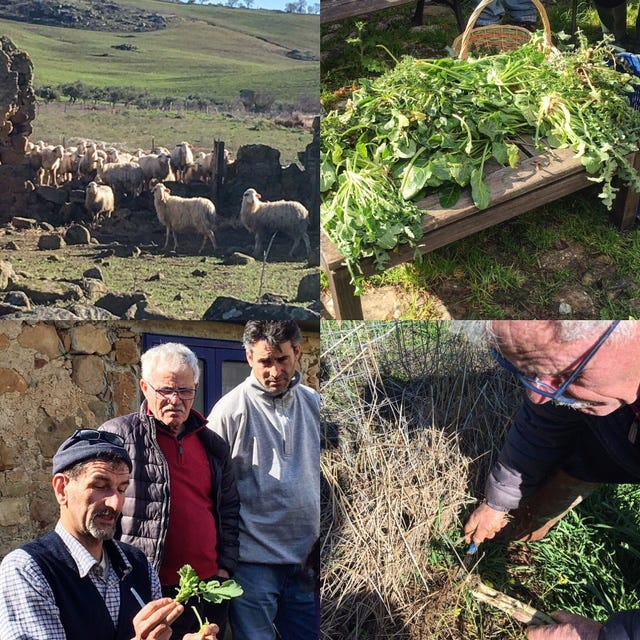
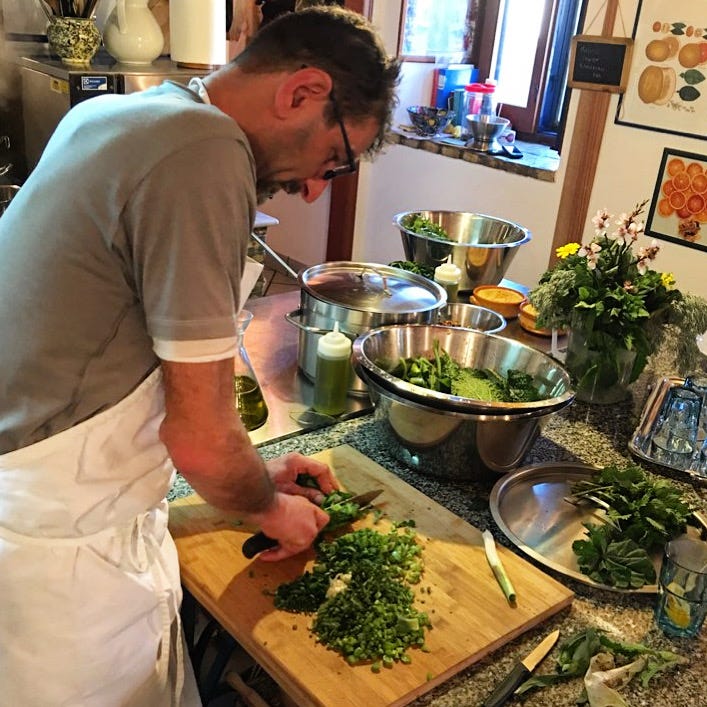


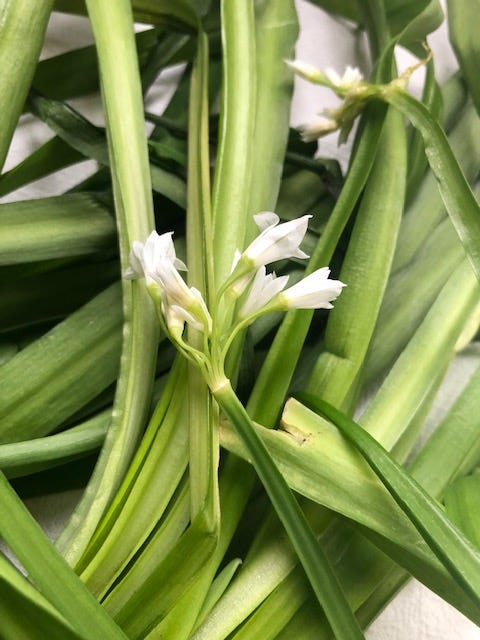
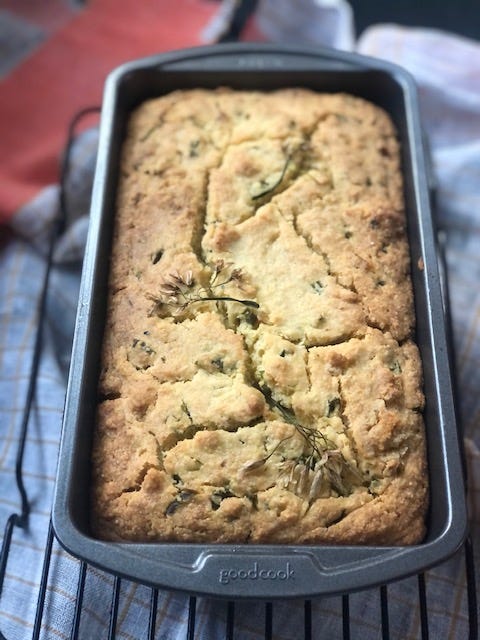
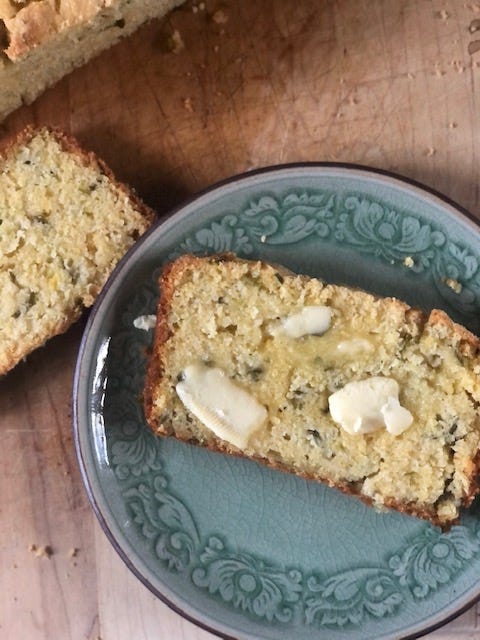
Ah...... memories of childhood. I remember going mushroom picking with mom and dad - seems to me I see the Ambassador Bridge nearby - I feel like it was somewhere below this bridge where we found mushrooms. I actually can still smell the wet earth and the mushrooms. Thank you ❣️ for the memories Elizabeth!
I also remember the mushroom forging with memories quite similar to yours! What I vividly recall is the delicate beauty of the small white treasures discreetly nestled in the grass. Back at home they were carefully washed and cooked in oil. In my mind, I can still taste these mushrooms that seemed to melt in your mouth.